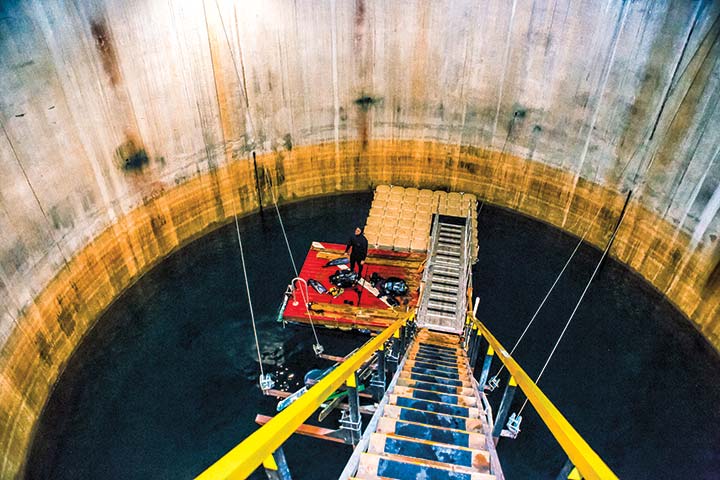
I’ve always considered myself a pretty brave guy. I’ve gone hang gliding, swum with stingrays, and even eaten face-melting ghost chiles. However, standing in the damp coolness of an underground nuclear missile silo, contemplating scuba diving into the black waters below me, I was overcome by an unexpected feeling: gut-wrenching fear.
Dive Valhalla
For information about scuba diving the Valhalla Missile Silo, call the Family Scuba Center at 866/217-2822.
I had driven for hours to the middle of a rolling prairie about 20 miles south of Abilene for a chance to dive the Valhalla Missile Silo, one of 12 Atlas intercontinental ballistic missile sites that the U.S. military built in Texas in the 1960s to brace for nuclear war. Mark Hannifin, who owns the silo with his wife, Linda, met our group on the surface to escort us into the bunker below.
The smell of rusted metal was as thick as the tension of the Cold War as we made our way down five flights of stairs and through blast doors composed of solid steel. The silo itself is 52 feet wide and extends 174 feet underground. Its concrete walls are up to nine feet thick in places.
The tight corridors widened as we stepped into the control room—where two-man teams once worked in 24-hour shifts awaiting the word to push the proverbial red button—and then through a tunnel to the missile tube.
The military shut down the Atlas missile program in 1964, leaving Valhalla and other Atlas sites for scrap. After years of neglect, the silo slowly filled with groundwater. Mark bought the silo around 1982, tested the water to ensure its safety, and 10 years later, opened it up to organized groups looking for a dive that would make even James Bond skittish.
“We bought it during our armchair survivalist mode. We thought it would be a good place to start off our prepper pad,” Mark says. Eventually, Mark started scuba diving the silo and decided to open it to diving groups.
“The divers that come down here tend to be more adventure-seeking and more dedicated,” Mark says.
Diving here had seemed like a good idea weeks earlier when I made my plans. But staring at the water made me question my decision—and also my sanity. Choosing to bury my fears and press on, I suited up with all the essentials, including a very thick wetsuit to withstand the silo’s 60-degree water. I descended the final staircase, sat on the edge of the floating dock, turned on my dive light, and splashed in.
As we floated down, the bright flood lights on the surface faded out, leaving us with only the dim beams from our handheld lights. The water was dark, but surprisingly clear as the concrete walls are permeable, allowing the groundwater to circulate and refresh itself. At a depth of 45 feet, we arrived at our first point of interest: a platform clinging to the silo’s wall that once housed the inertial navigation system. Using guidance from the North Star, this system could lock the missile’s aim on anything within its 6,000-mile range. We lingered for a few minutes and then headed deeper.
With no points of reference along the silo’s smooth concrete walls, it was nearly impossible to tell how far we had traveled. However, at roughly 110 feet below the water’s surface (160 feet below the earth’s surface) my light reflected off a twisted piece of metal—our signal that we had finally reached the bottom.
The silo’s floor was covered with bent steel beams and mangled industrial platforms that had escaped the scrapyard. Due to the water’s depth, we couldn’t stay down very long for risk of nitrogen build-up in our blood. After a few minutes of exploration, we made our way to the rope that would lead us back to the surface. As we ascended, soon a few pinpoints of light pierced the void and slowly grew brighter and brighter until I could make out the underside of the dive platform.
After a brief decompression stop to allow nitrogen to escape our blood, I surfaced with an overwhelming sense of accomplishment. Not only had I overcome my fears, but I had just taken part in one of the most unusual scuba dives in the world, let alone Texas. There were no fish, no exotic coral reefs, yet this dive was truly one of the most amazing experiences I’ve ever had underwater.








